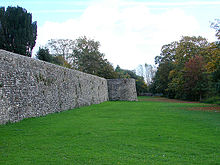- Noviomagus Reginorum
-
Coordinates: 50°50′13″N 0°46′48″W / 50.837°N 0.780°W
 Chichester City Walls. The Roman walls were heavily modified in the Middle Ages, and the facing stones are the result of 19th century restoration.
Chichester City Walls. The Roman walls were heavily modified in the Middle Ages, and the facing stones are the result of 19th century restoration.
Noviomagus Reginorum was the Roman town which is today called Chichester, situated in the modern English county of West Sussex. Alternative versions of the name include Noviomagus Regnorum, Regnentium and Regentium.[citation needed].
Contents
Development
Noviomagus Reg(i)norum, meaning 'new field' or new clearing of the Reg(i)ni,[1] was first established as a winter fort in the friendly territory of the Atrebates tribe, shortly after the Roman conquest in AD 43. It was the home of the Legio II Augusta commanded by the future Emperor Vespasian [2] and their timber barrack blocks, supply stores and military equipment have been excavated. The army only stayed for a couple of years and the site was soon developed as a civilian settlement and capital of the Civitas Reginorum, a client kingdom ruled by Tiberius Claudius Cogidubnus.
The Regnenses were either a sub-tribe of the Atrebates or simply the local people designated the 'people of the Kingdom' by the Roman administration. Cogidubnus almost certainly lived at the nearby Palace of Fishbourne. He is mentioned on the dedication stone of the temple to Neptune and Minerva found in Chichester. Other public buildings were also present: the public baths are beneath West Street, the amphitheatre under the cattle market and the basilica is thought to be beneath the cathedral.
 Inscription discovered at Chichester in 1723. From a temple dedicated to Neptune and Minerva, erected on the authority of Tiberius Claudius Cogidubnus.
Inscription discovered at Chichester in 1723. From a temple dedicated to Neptune and Minerva, erected on the authority of Tiberius Claudius Cogidubnus.
The town became an important residential, market and industrial centre, producing both fine tableware and enamelwork. In the 2nd century the town was surrounded by a bank and timber pallisade which was later rebuilt in stone. Bastions were added in the early 4th century and the town was generally improved with much rebuilding, road surfacing and a new sewerage system. There were cemeteries outside the east, north and south gates.
Decline
By the 380s, Noviomagus appears to have been largely abandoned, perhaps because of Saxon raids along the south coast. According to the Anglo-Saxon Chronicle the town was eventually captured towards the close of the 5th century by Aelle of the South Saxons. It was renamed after his son, Cissa, and probably retained as a royal residence.
Remains
- The dedication stone of the temple of Neptune and Minerva is now set into the wall of the Assembly Rooms.
- Part of a fine Roman mosaic may be seen in situ beneath the floor of the cathedral.
- A second mosaic from Noviomagus may be seen at Fishbourne Roman Palace.
- One of the town's bastions may be seen in the gardens of the Bishop's Palace.
- The Chichester District Museum houses many finds from across the city.
See also
- Chichester Castle – medieval castle established in the north of Noviomagus Reginorum
References
External links
Major towns of Roman Britain Londinium (capital of Britannia Superior) - now London
Eboracum (capital of Britannia Inferior) - now York
Camulodunum (first 'capital' of Roman Britain) - now Colchester
Bannaventa* (Northamptonshire) • Caesaromagus - now Chelmsford • Calleva Atrebatum* (Hampshire) • Corinium Dobunnorum - now Cirencester • Deva Victrix - now Chester • Durovernum Cantiacorum - now Canterbury • Durnovaria - now Dorchester • Glevum - now Gloucester • Isca Augusta - now Caerleon • Isca Dumnoniorum - now Exeter • Isurium Brigantum - now Aldborough • Lactodurum - now Towcester • Lindum Colonia - now Lincoln • Luguvalium - now Carlisle • Moridunum - now Carmarthen • Noviomagus Reginorum - now Chichester • Petuaria - now Brough-on-Humber • Ratae Corieltauvorum - now Leicester • Venta Belgarum - now Winchester • Venta Icenorum* (Norfolk) • Venta Silurum - now Caerwent • Verulamium - now St Albans • Viroconium Cornoviorum* (now Wroxeter in Shropshire)See also: List of Roman place names in Britain * Towns labelled with an asterisk have not grown into a modern UK location (their county is shown instead)Categories:- History of West Sussex
- Archaeological sites in West Sussex
- Roman towns and cities in England
- Chichester
Wikimedia Foundation. 2010.
